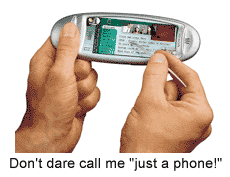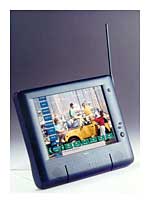|
Britain's cellular bonanza
|
 |
April 28, 2000: 12:23 p.m. ET
$35B bill for Britain's new mobile licenses could make or break industry
|
LONDON (CNNfn) - The stunning $35.5 billion that five telecom companies this week agreed to pay for Great Britain's next-generation mobile-phone licenses has huge implications for the development of the industry, as well as the earnings potential of the winners.
Britain is the first of the major cellular markets to use an auction process to allocate licenses for third-generation UMTS cell phone services, commonly known as 3G licenses. The licenses allow operators to offer fast Internet access through mobile phones and services such as high-quality video and data feeds.
Industry experts view UMTS as the holy grail of the communications business, melding a global mobile market expected to reach 1 billion users within 10 years with the vast commercial opportunities of the Internet.
While estimates of the licenses' value had crept up in the weeks before the auction, even the losing bidders - such as Finnish telecom market leader Sonera -- express a weary resignation at the final bill facing the players.
"It was not a surprise that prices were finally higher than we had wished for," Sonera's Matti Makkonen, executive vice-president for mobile operations, told CNNfn.com.
Sonera was keenly watched by analysts because of its experience in developing 3G services in its domestic market, and also successfully bid for a 3G license in Spain. Some analysts suggested that if Sonera could not make a license pay, the eventual winners would face an uphill task.

The Finnish company dropped out of the race for license A, which was reserved for new entrants to the British mobile market, after 95 bidding rounds. The final price of over £4 billion ($6.25 billion) was more than twice Sonera's final offer.
Most other national governments have so far taken the 'beauty-contest' approach to allocating mobile network permits, whereby the winners are selected mainly on the basis of their ability to provide depth and quality of continuing service, rather than to offer up the largest chunk of cash.
However, the lure of the billions raised for the British treasury -- as much as eight times the government's initial estimate -- has led to a wholesale review of the value of the licenses and the potential demand for services.
"The U.K. is setting a very tempting precedent for other European governments," analysts at Merrill Lynch in London said in a note to clients. "The short-term appeal of billions in 'easy' revenues will be a hard one to resist."
The fate of the five highly-prized licenses for the United Kingdom, Europe's second-largest mobile market, was decided on Apr. 26 after a six-week auction that reduced the initial 13 applicants to five after 150 rounds of bidding conducted via the humble fax machine.
Britain's four existing cellular network operators -- Vodafone AirTouch (VOD), British Telecommunications' (BT-A) BT Cellnet unit, Deutsche Telekom's (FDTE) One2One, and Orange, soon to be sold by Vodafone -- all secured licenses, because they had to.
"The prices being paid are undoubtedly much higher than everyone expected," said Mandeep Singh, a sector analyst at ABN Amro in London. "But it is absolutely essential for an existing operator who has a captive customer base with market values of billions of dollars to capture these licenses to secure their future." 
The one license reserved for a new entrant was secured at a cost of £4.3 billion by a consortium bringing together Canadian-based Telesystems International Wireless (TIWI: Research, Estimates) and Hutchison Whampoa, a Hong Kong conglomerate.
Analysts have warned that the successful bidders may take 15 years to recoup their investment, amid concern that the launch of global 3G services could be delayed by equipment shortages and other technical problems.
U.S.-based consultant Forrester Research warns that it could take seven years for 3G networks to become operational compared to a two-year estimate from Nokia, the world's largest mobile-phone maker. Forrester also estimates that the winners of the British licenses will each have to spend about $5.6 billion to develop the infrastructure for 3G services.
Europe eyes British windfall
The complex British auction process of multiple auctions appeared to succeed in one of its primary aims: maximizing the proceeds of the license sale. It was designed by academics at the London Business School using advanced game theory, a branch of mathematics. Bidders also drew on game theory in adapting their business plans to the rising costs.
The British bonanza stands in stark contrast to the approaches used in Finland and Spain, the two countries that have already issued 3G licenses. Spain auctioned four licenses last month, charging a one-off payment of  130 million but also levying royalties of 0.15 percent of 3G operators' annual sales. Finland held a beauty contest, and most of the other upcoming license awards in Europe's other major cellular markets are scheduled to follow suit (see table, below), as is Japan later this year. 130 million but also levying royalties of 0.15 percent of 3G operators' annual sales. Finland held a beauty contest, and most of the other upcoming license awards in Europe's other major cellular markets are scheduled to follow suit (see table, below), as is Japan later this year.
Germany is the only country that so far plans to follow the U.K. example of a multiple-round auction. Analysts now estimate that Europe's largest mobile market could draw bids totaling as much as $50 billion for the maximum of six licenses on offer. Two more countries, Switzerland and the Netherlands, plan to auction licenses by calling for single, sealed, ruling out the prospect of a repeat of Britain's spiraling prices.
 The French government has said it will not opt for an auction, but in the light of the British experience, may charge a market entry fee plus a share of annual revenues. Italy is examining a similar path. The French government has said it will not opt for an auction, but in the light of the British experience, may charge a market entry fee plus a share of annual revenues. Italy is examining a similar path.
The benefit of the British system is clear: a huge windfall for the government, which will flow into the coffers of finance minister Gordon Brown ahead of the expected election next year. Free-market economists also trumpet the notion that companies paid only what they felt was required. The system also produced a useful counter to criticism of earlier low-priced sales of government assets, such as utilities, during the late 1980s and early 1990s.
The downside is that the high price paid for each of the licenses threatens to frustrate development in Europe's second-largest cellular market. The initial prices cut into direct investment funding, and consumer advocates have warned that the high prices paid are likely to be reflected in steep prices charged to consumers.
Who pays: users or investors?
The auction system already has a checkered history in the United States, where mobile penetration lags well behind most of Europe. Analysts believe that the auction of second-generation licenses during the 1990s removed investment funds from the sector, limiting the introduction of high-quality national mobile coverage.
"The challenge for license winners is of course now bigger," said Makkonen at Sonera. "It will force them to make savings in other investments and be more aggressive in service development."
The drain on the winners' balance sheets - half of the auction price has to be paid up front - has already led rating agency Standard & Poor's to warn that it might lower their credit ratings.
S&P said "substantial uncertainty" exists over future demand for UMTS services and the revenue that license winners could expect to generate. Many analysts privately believe that, rather than passing on the cost of the license bids to consumers, companies will force shareholders to bear the brunt through lower earnings.
Competitive pressures to launch 3G services that are both attractive and timely - compounded by the prospect of new entrants coming in if more spectrum is sold - will keep prices low relative to the improvements in service that UMTS can offer.
Japan provides the clearest example of the potential of UMTS. NTT DoCoMo, the country's largest cellular firm, which launched mobile phones with limited Internet access in March 1999, had signed up 5 million users by the end of March this year and is adding 150,000 a month.
Makkonen noted that much of the success of the new services could be put down to low subscription prices charged to new users, and the fact that much of the higher-quality network infrastructure needed for advanced services already existed in Japan, whereas in Europe it will have to be built afresh.
The UMTS phones being developed by Nokia and its rivals bear little resemblance to the mobiles in service today. If they could, the new telephones would probably beat you over the head for describing them as such - engineers may even be building such a capability into their devices right now.
The new phones range in size from that of a cigarette packet to an A5-envelope, with a flat screen the central feature rather than an earpiece, complete with keyboard. But if users fail to love the 3G "phone" and all it promises, it will be the operators that are left with sore heads. 
|
|
|
|
|
 |

|

